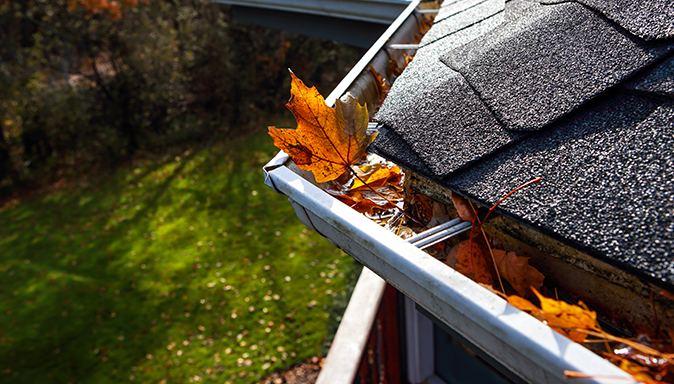As summer winds down, thoughts turn to cozy sweaters, pumpkin spice everything, and piles of colorful leaves—so many fall leaves.
And while the National Wildlife Foundation advises homeowners to leave the leaves where they fall to nourish your lawn and provide food, shelter, and nesting material for wildlife and insects, you most definitely do not want to leave the leaves that are clogging your gutters.
When gutters are clogged, water can back up, overflow, and cause damage from your roof all the way down to your foundation. That’s why cleaning gutters in the fall is one of the smartest home maintenance tasks you can take to prevent leaks, avoid costly repairs, and keep your home protected all season long. Here’s how to get your gutters fall-ready.
Clean Out Gutters and Downspouts
The first—and most important—step is to give your gutters a thorough cleaning. Over time, leaves, twigs, pine needles, and other debris build up inside gutters so when heavy rain hits, water can’t flow through them properly, leading to backups that spill over the sides.
How to clean gutters:
• Set up a sturdy ladder on flat ground.
• Put on gloves and use a gutter scoop to remove debris.
• Flush the gutters with a garden hose to clear out any remaining dirt and check that water can flow freely through the downspouts; if it’s not draining, use a plumber’s snake or pressure nozzle to dislodge clogs inside the downspout.
Inspect for Rust, Leaks, or Sagging
Once your gutters are clean, take a good look at their condition. Over time, gutters can sag, rust, or start to leak. Spotting signs of wear and tear now can save you from bigger headaches later.
What to check:
• Rust or holes: Metal gutters can rust or corrode, especially if water has been sitting in them. You can patch small holes with gutter sealant, but if rust is widespread, it may be time to replace entire sections.
• Leaks at joints: Pay attention to seams where gutter sections connect. If you see drips or watermarks, reseal them with waterproof caulk.
• Sagging or pulling away from the house: Gutters that sag under the weight of debris or water won’t drain properly. Tighten the brackets or replace damaged hangers to keep them securely in place.
Inspect your fascia boards (the wood behind your gutters) while you’re at it. Water damage to fascia boards can cause gutters to detach completely. If you see soft spots or rot, boards may need to be repaired before you reattach the gutters.
Install or Repair Gutter Guards
Cleaning gutters is a dirty job. Keep them running clear by adding gutter guards after cleaning. These protective covers sit on top of your gutters to block leaves and debris while still allowing water to flow through. Watch this video to find the product that’s right for your home:
Pro tip: Already have gutter guards? Sometimes they can come loose, develop gaps, or still let smaller debris like pine needles or granules from roof shingles through. Check them as part of your fall prep to keep them working.
Redirect Downspouts Away from the Foundation
Even if your gutters are clean and in good condition, they won’t protect your home if stormwater isn’t draining away from your home. If downspouts are depositing water right at the base of your house, you risk foundation damage, basement leaks, and soil erosion.
What to do:
• Make sure downspouts extend at least 4–6 feet away from the foundation. If not, add a Tilt and Drain downspout extension to direct water away from your home and into the yard. This easy-to-install extender swivels 180 degrees so you can completely control where the water flows.
• Check that the ground slopes away from your home so water isn’t pooling around the foundation. If water is pooling, you may need to regrade your yard.
Pro tip: Consider installing a rain barrel at one of the downspouts. Not only will it reduce stormwater runoff, it conserves a free source of water for your garden.
Why Fall Gutter Maintenance Matters
Ignoring your gutters might not cause immediate issues, but over time damage can add up. With just a few hours of work, you can prevent costly problems and save thousands of dollars in repairs:
• Roof leaks: Overflowing gutters can force water under the shingles, leading to roof damage and interior leaks.
• Foundation cracks: Water pooling around the foundation can cause it to weaken and shift, leading to expensive repairs.
• Basement flooding: Poor drainage can cause dampness and basement flooding.
• Landscape damage: When water spills over clogged gutters, it can wash away mulch and soil and damage shrubs and plants.
• Pest problems: Stagnant water in clogged gutters attracts mosquitoes and other insects.
Safety First
Before you get started, remember that cleaning gutters can be a dangerous job. Follow these tips to stay safe:
• Always let someone know you’ll be working outside.
• Use a sturdy ladder with slip-resistant feet.
• Avoid working on the roof if it’s wet or icy.
• If your gutters are more than one story high or if you’re uncomfortable being up on a ladder, hire a professional gutter cleaning service.
A Seasonal Habit Worth Keeping
Gutter cleaning is one of those small but important tasks that protects your home year after year. Make it a seasonal ritual—like raking leaves or winterizing outdoor faucets—so instead of worrying about water damage, you’ll be free to enjoy crisp autumn evenings, cozy sweaters, blazing bonfires, and all the other good stuff fall has to offer.
